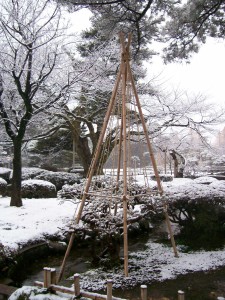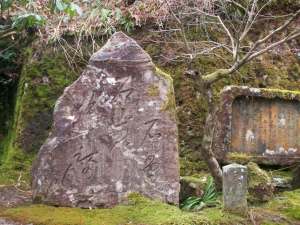
I’ve been to Japan once, to visit a friend who was teaching English in a city called Kanazawa. Kanazawa is known for several things, including the only remaining working Geisha district besides the one in Kyoto, the production of 98% of the gold leaf in Japan, and the second garden in Japan, Kenroku-en. (I’m not actually sure what the first is; presumably one in Kyoto; and second-most — famous? beautiful? it certainly is beautiful.) It was lovely:

I particularly loved the ropes tied to trees, which made them look like ship’s masts or party trees or something magical, though apparently they have the prosaic task of preventing broken branches from the heavy wet snow of the area:
And which looked especially cool from below:
I also went to Kyoto and Nara, and saw some of the famous Zen gardens there. One that particularly struck me was called Ryo-ku-en, which I’d heard about because of Monty Don’s Around the World in 80 Gardens. What I thought particularly cool about it was how there are fifteen stones in the garden, but they are so arranged that it is impossible to see more than fourteen at any one time. Fifteen is a number associated with enlightenment, you see, and that is not found so easily. As a philosophical statement, this has stayed with me.
In Nara I visited a few gardens, including one that was the best example of the principle of “borrowing the landscape” that I have ever seen. The idea here is that when one designs a garden, one can arrange the plantings and structures in such a way to make the landscape beyond the garden’s borders look as if it belongs to it. This isn’t quite as simple as framing a view, though that’s part of it; it’s also a kind of illusion whereby the outer world becomes part of the garden’s design.
In this case, the building in the background, which looks like a shed just behind the trees, is the roof of the world’s largest wooden building, and is probably about a kilometre away. There’s a whole neighbourhood in between the two, in fact.
When I talked about drawing instead of Dante for D, someone in the comments asked about how I’d relate the two to each other. I don’t really have a good answer for that — I’m still thinking about it — but I have thought about how this principle of borrowing the landscape works in relation to intertextuality in literature. Intertextuality is basically the relation of texts to each other, specifically how one book alludes to another (or many others) within it. This can take many forms, from parody to simple quotation to elaborate riffs to rewriting the story.
A reasonably straightforward example would be something like West Side Story and Romeo and Juliet: you can watch the former without knowing the latter, but knowing the latter brings a weight of resonance and cultural significance to it. A book like Silverlock, by John Myers Myers, which is a journey through the Commonwealth of Letters — quite literally, the main character gets shipwrecked on what turns out to be Circe’s island, and travels from there via Norse sagas, As You Like It, what I think is Herman Melville’s The Confidence Man, and many others to the fountain of the Hippocrene — is a more elaborate example of intertextuality, a game for the well-read reader.
Some books invoke other texts to borrow their landscape, to draw down the whole world of that story into the background of their own. This usually happens with major works, because the point is to work against and from a cultural touchstone; and because of that, it can be very dangerous. For all the Dantes who effectively invoked Virgil (who was himself doing this with Homer), there were an awful lot of mediocre poets in the Middle Ages who tried to do the same thing and failed — not so much because their poems were all that bad, but because they were being read against the backdrop of the great, and were not flattered by the comparison.
I suppose that could happen with gardens, if you brought in the landscape that was far more stupendous than the garden, but generally speaking, you’re invoking the natural world in relation to the cultivated, and that’s a different comparison. People strewing the visual language of Japanese (or other strong) garden design without understanding the principles behind them are the ones more in danger of poor comparisons. But gardens tend to be a bit more forgiving, because plants are usually beautiful in themselves.
As for the Japanese gardens … well, I think of them often when I think about what can be done with gardens, and also with literature.








I’m particularly taken by the garden arranged so that only fourteen of the fifteen stones may be seen from any given point.
LikeLike
What a lovely reminder of our time together in Kanazawa and the beautiful balance of a Japanese garden. I love the photo from under the yukitsuri (the ropes keeping the snow off the branches). I used to find that those ropes became so much a part of the tree and the harmony of Kenrokuen in general. Such true harmony in their cultivation.
LikeLike
How interesting this is, interviewing landscape with novels .. Thank you for this post Kathryn … and the beautiful photographs!
Garden of Eden Blog
LikeLike
sorry that should have been interweaving not interviewing!
LikeLike
Although interviewing a landscape is certainly an intriguing idea …
LikeLike